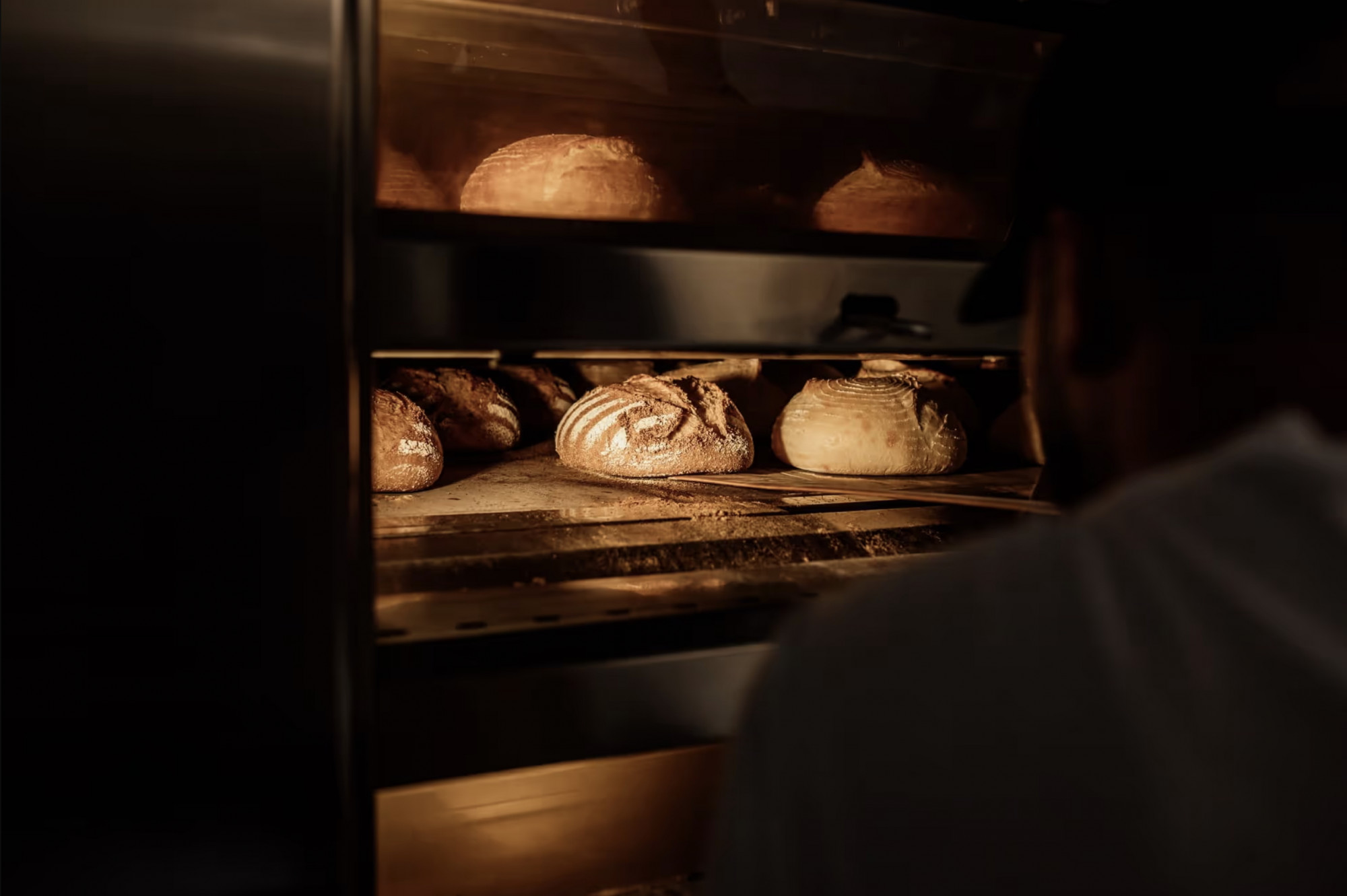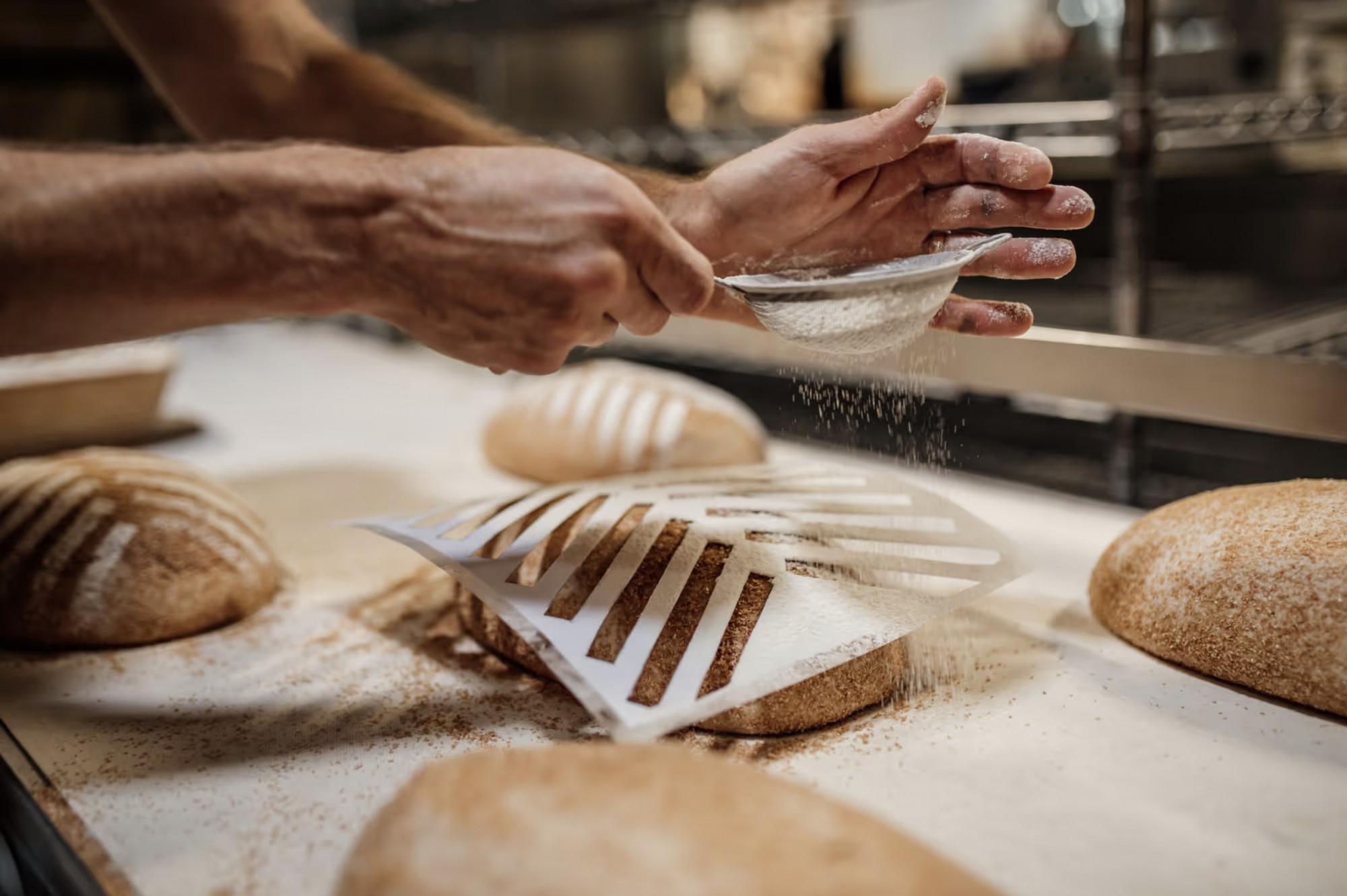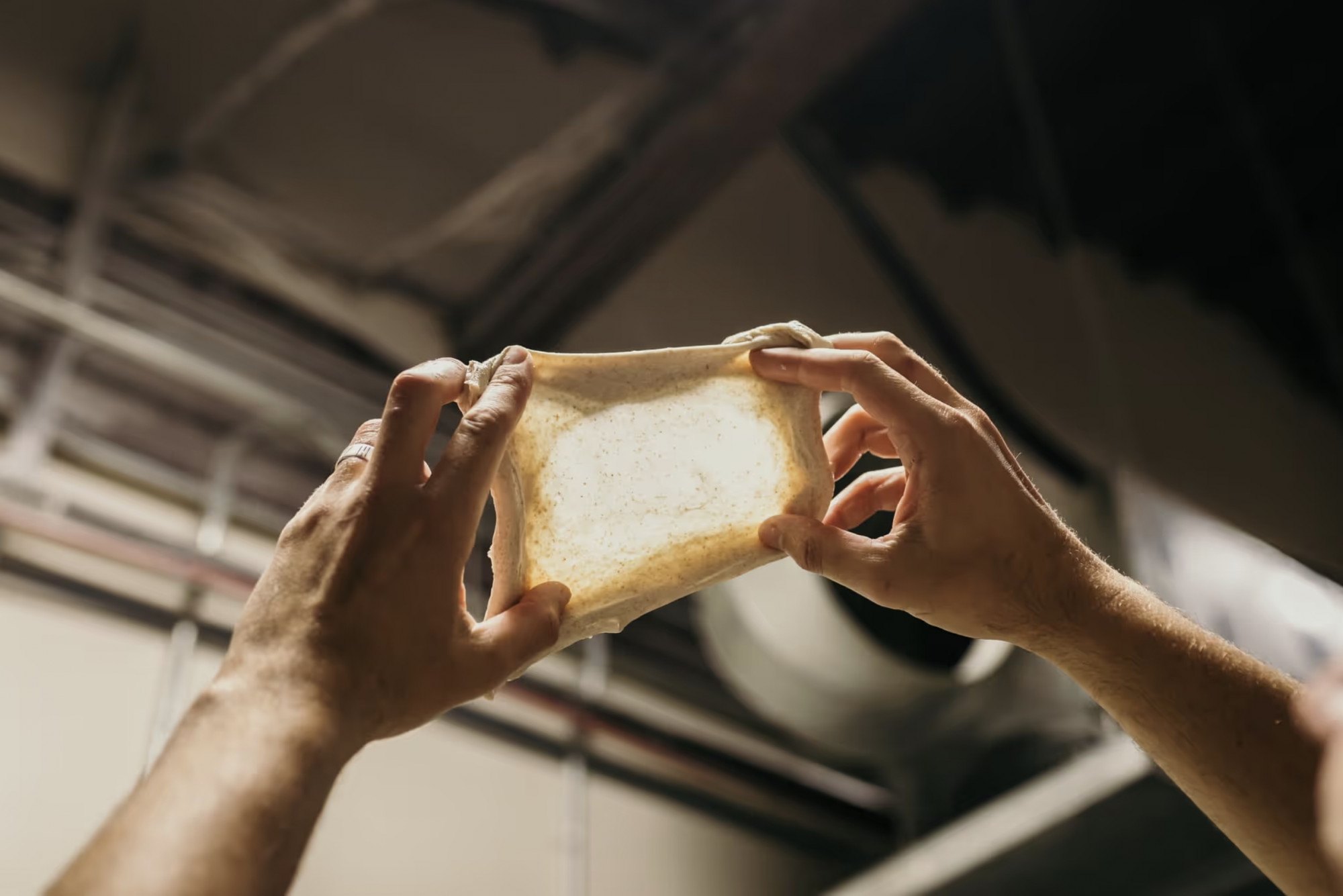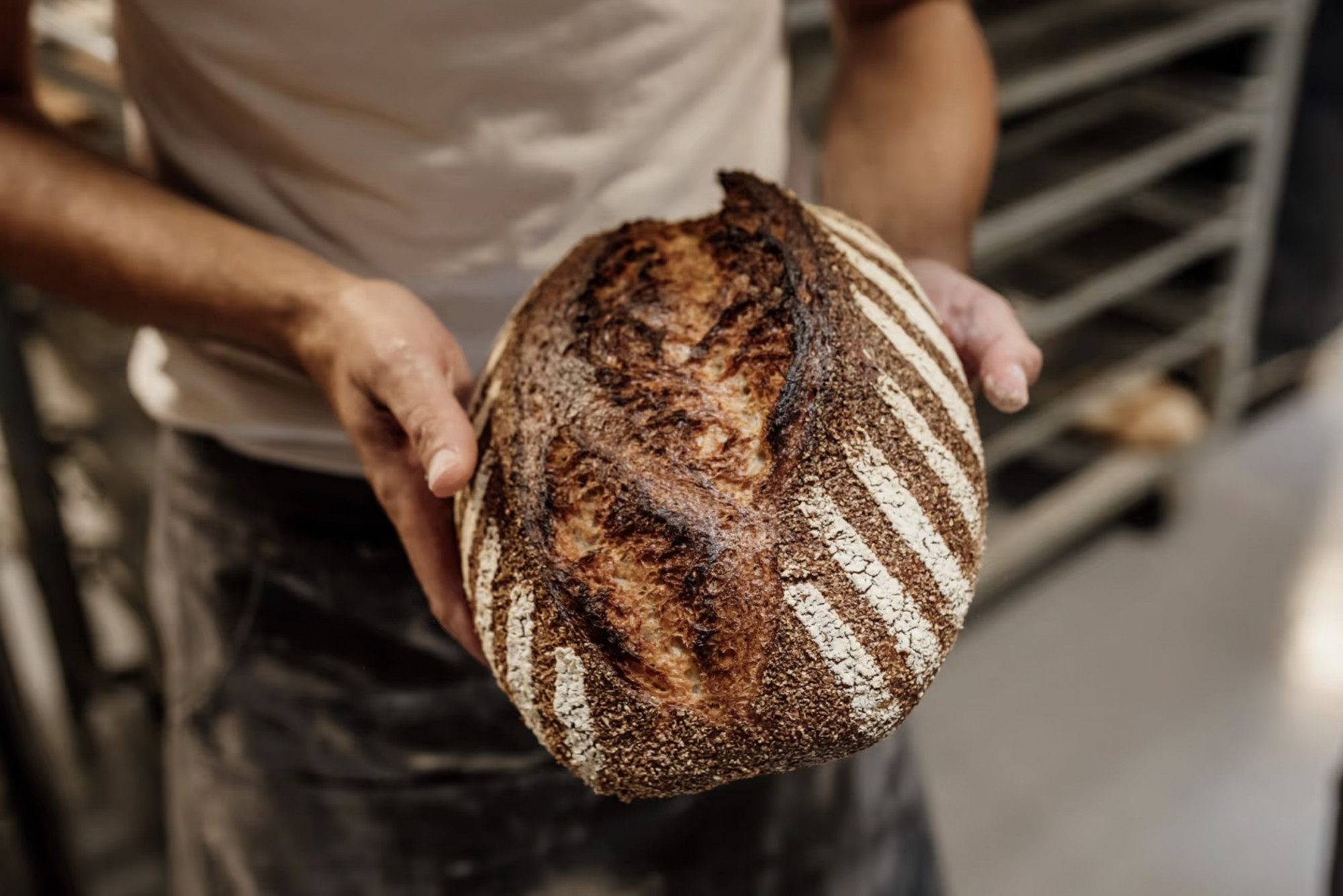A Local Loaf
One bakery’s quest to make truly homegrown bread
By David Cook

Photo by Food as a Verb, Sarah Unger
A few years ago, Erik and Lauren Zilen began counting hands. The husband-and-wife owners of Niedlov’s Bakery and Café in Chattanooga, Tennessee, were trying to put a number on everyone involved in making one loaf of Niedlov’s bread. “How many sets of hands did it take?” Erik wondered.
In 2016, Erik and Lauren bought Niedlov’s. Soon, it became Chattanooga’s cornerstone bakery: long lines, loaves on store shelves and in restaurants throughout the region, special Einkorn heirloom loaves. In other words, the go-to place for both Gen Z and grandparents. From his restaurant next door, James Beard–nominated chef Erik Niel called Niedlov’s “integral” to Chattanooga’s foodscape.
Erik Zilen’s a Midwesterner; Lauren Zilen, from Portland, Tennessee, near the Kentucky border. They are both huggers, big-hearted and amiable, their generosity running parallel with a rebellious streak. The Zilens bought a building nearby; their family lives on one floor, with immigrant, refugee, and single-parent families living on the others—whoever needs affordable housing. Niedlov’s regularly hires folks coming out of prison, sources from more than a dozen local producers, composts 1,300 pounds of food waste each month, and freely gives away hundreds of loaves and thousands of sandwiches to those in need through local nonprofits. Given the chance to vacation, they choose an off-grid cabin in the Maine woods. Up late at night, Erik will reach for books on heirloom grains. “He’s a nerd,” Lauren jokes. During COVID, they printed t-shirts: bake bread, avoid plague, and revolt.
After college, Erik—with an econ degree—backpacked overseas, where he encountered the European bakery as the cornerstone of community. “I can remember different parts of Europe, falling in love with bread,” he said. “I’d just sit and watch bakers and bakeries.”
That’s when the first question arose. “This bread in Europe—” he began. “Can we do that here in Tennessee?”
Good with his hands, he pivoted to baking—the Baking Institute of San Francisco, apprenticeships with master bakers in Europe, more classes, and grain conferences. All this led to an abiding interest in ancient whole grains. As Erik and Lauren cashed in their savings to buy Niedlov’s, they wondered, How many hands does it take?

Photo by Food as a Verb, Sarah Unger
When celebrated food author Michael Pollan suggests we shake the hand that feeds us, he’s really suggesting intimacy. By knowing our baker, miller, farmer, we know our food, as well as the land and the process by which so much—from earthworms to bakers—can work together. The food becomes more real.
If it takes 150 hands, say, to bake one loaf of bread and we can’t name, know, or join in fellowship with any of those people, then we have foggily drifted from the source of so much of our lives. Our food has no face. No history. No meaning.
Even at Niedlov’s, there is a lot of not-knowing. Take organic flour. Niedlov’s orders fifteen pallets every eight weeks—every pallet holds fifty bags; each bag is fifty pounds—from Central Milling in Utah. Twice a month, Erik submits his online order; several weeks later, a long-haul trucker arrives to forklift pallets into the bakery.
It’s all removed, isolating, amnesia-producing. “You just forget,” he said. “You don't have to lean on anyone.”
Two years ago, the Zilens loaded the kids into a rented van and trekked out West. Mixing the Great Sand Dunes with grain, they spent a few days touring Central Milling in Utah. They wanted to shake the hands that had been cleaning and milling their grain.
Long stretches of Midwestern highways give a man a lot of thinking time. Erik tallied up a dozen hands here and there—long-haul truckers, farmers, Niedlov’s 3 a.m. bakers—in every loaf. Returning home, he knew his number: twenty-five sets of hands.
“Can we reduce that?” he wondered. “Can we bake a truly local loaf?” The answer would prove more difficult and rewarding than he could have imagined, becoming part detective story, part adventure, part foodways revelation.

Photo by Food as a Verb, Sarah Unger
Here’s a very long story made short: Some 10,000 years ago, humans began domesticating wheat, milling it into flour, baking bread with it. We are descendants of this Fertile Crescent miracle; no part of modern culture today would exist without that. Over time, bakers and bakeries became community cornerstones. Then, more creations: electricity, the Industrial Revolution, interstates and airplanes, the Green Revolution, global trade, and a population in the billions.
In the 1950s, farmers began to grow newly developed high-yield grains in response to this changing world. “After World War II, grains were introduced to intense, scientific plant breeding for the purpose of getting the highest-yield crop, not necessarily to match quality,” Erik explained. “Heirloom wheat is defined as varieties that were developed before World War II and have had limited breeding selection. Heirloom varieties have deeper roots, are rich in flavor and denser in nutrients.”
Heirloom and ancient grains are modern terms for breads and grains grown for centuries. Spelt. Millet. Farro. Sorghum. They are also whole grains, which means the entire grain head—germ, endosperm, and bran—are all present. Processed grain, however, removes, crushes, or edits out part of the grain.
So, for Erik to bake a truly local loaf of bread, he had to identify regional farmers growing organic, heirloom grains, as well as millers, threshers, and cleaners, all near Chattanooga.
In East Tennessee, these folks are hard to find. The vast, rolling fields on the western side of the state crunch up like a folded map as you move east. The Appalachian Mountains and their foothills make large-scale grain-growing difficult.
And without East Tennessee growers, why would millers exist here? Or threshers and cleaners? Like is the case for much of the American food system, the work had become compartmentalized and siloed. Done elsewhere.
It became his own Little Red Hen story, as Erik wondered, like that fabled chicken: Who will help me bake this bread?
One friend stepped forward. From his Baylor School garden, where he taught high school students organic gardening just ten minutes from Niedlov’s, Dr. Robin Fazio, who used to farm wheat and peanuts in South Georgia, taught his students to broadcast and sow a one-eighth-acre of Appalachian White, a hard white winter wheat. Sure, their plot was barely enough to fill bakery shelves, but it was something. The Zilens were heartened.
Dead ends followed. Erik began talking to real estate agents about leasing land nearby. He’d need at least fifty acres, plus equipment, plus gobs of time to grow his own grain, a daydream that would quickly prove elusive for the small-business owner and father of two young kids.
He’d heard about a cleaner here, a miller there, a grower in Kentucky, but every time he’d make a call, the trail would go dead. This farmer had stopped growing. The miller had closed. So-and-so died a few years back.
Then someone mentioned Murray Brett.

Photo by Food as a Verb, Sarah Unger
In September 2011, Murray Brett and his son bought some land with the idea of running scrub cattle on their DaySpring Farms north of Atlanta. On a whim, they also planted three acres of NuEast, a hard red winter wheat variety developed by Dr. David Marshall from North Carolina State University, who Murray calls a “world-class wheat breeder.” Along with NuEast, Marshall bred Appalachian White.
Murray said the South should tip its hat to Marshall for his pioneering work. “Paying our respects is needed for everyone’s good,” said Murray.
At DaySpring, NuEast grew and flourished. “Well, we need to harvest this,” the Bretts said. They bought a used combine. Then, a seed cleaner. Here’s how it works: Each individual stem of wheat heads out. The heads contain berries. Once wheat heads are cut, or harvested, they need to be cleaned and milled. In the old days, this was communal, on-the-farm work—threshing and cleaning grain to prepare for milling. Today, it’s mostly industrial. Removed. Except at DaySpring. The ingenious Murray rejiggered his own commercial seed cleaner and gravity table that sorts the berries by weight, allowing him to save, replant, and sell seed.
The following year, they planted fifteen acres of NuEast, cleaning and milling it all.
In our Little Red Hen detective story, Erik had just found one organic grain farmer who’s also a grower, cleaner, and miller. And, only a few hours away. “We’re the only farm I’m aware of within five hundred miles that grows its own wheat, cleans it, and has milling and sifting equipment, all certified organic,” Murray said.
DaySpring is three hours southeast of Chattanooga. Erik began regular trips, bringing fellow bakers and his own family. A friendship formed. Murray, who also pastors a small church, is that kind of person: warm, inviting, glad to work eighteen-hour days, never met a stranger.
He’s also got his own question: Can we grow hard winter wheat in the South, particularly heirloom and ancient varieties?
“The problem: you don’t have enough cold days,” he said. “Below I-20, you don’t have enough cold days for it to vernalize or head out. Plus, there was never enough commercial interest in the Southeast to grow hard wheat. No commercial seed company has taken up the wheat breeding program.”
Before the pandemic, he’d been growing a test plot for an Atlanta bakery; it was an heirloom wheat variety called Rouge. The bakery closed, but he kept growing.
Developed in nineteenth-century France, Rouge de Bordeaux is a deep brown, nutty-flavored, high-protein bread wheat. It grew fabulously well at DaySpring; Murray says the farm sells to dozens of bakeries, breweries, and restaurants in Georgia, including James Beard–winning chefs and master bakers.
Erik hemmed and hawed for most of the winter, wondering, “Can I really do this?” In the spring, his phone rang, “This is Murray. I’m bringing you a thousand pounds of Rouge next week.”
It was time to mill, “or get off the pot,” Erik said.
But he needed a miller.
“I know just the right folks,” a friend told Erik.

Photo by Food as a Verb, Sarah Unger
Years ago, Cynthia and Ron Shafer were vacationing in Louisville and spied a magazine cover spotlighting a local miller and thought, “We should try that someday.”
They were already running Red Clay Farm, a fifty-acre organic operation in Bradley County, Tennessee, producing microgreens, row crops, and homemade breads. In 2016, they eBay’d an Austrian-built mill from Spokane, which arrived without any instructions. The previous baker apparently threw them away.
“A Tyrolian stone mill,” said Ron.
The mill is gorgeous, with the singular Marie Kondo-ed presence of a grand piano or a Rothko. Forget its function—you could place it like furniture in the living room and just gape. The mill has two eighteen-inch circular stones. At the top, grain is fed into the hopper, then onto the two stones. Only the top stone turns. The mill is seven hundred and fifty pounds.
They called their neighbor, who has extensions on his tractor that could lift the mill. “He’s also legally blind,” Ron said.
It was an agrarian, surrealist comedy sketch: a blind farmer on his tractor navigating an Austrian stone mill with a quarter-inch leeway on either side of the door as Ron and Cynthia hollered: steer this way, that way, look out for the wall!
A stone mill is different from a steel mill, which is often used in large commercial production. White bread from white flour? That’s a steel mill. “When you buy flour in the store that is white, they’ve removed the bran, endosperm, leaving the germ,” Ron said. A stone mill mills all of it together. Thus, whole wheat. Stone-milled flour is more nutritious because nothing is removed. (Red Clay gets its organic grain from growers in Oregon.)
Once a week, Erik would drive a Niedlov’s minivan, loaded up with bags of unmilled DaySpring Rouge, to Red Clay Farms. For hours, he’d understudy with Ron, who soon handed over the reins: Erik would mill, then return to Niedlov’s to bake, a process that now felt different. More attuned. More connected. “When you’re out there and you see somebody working hard, toiling over their crop and land, you see him with the cleaner and all this effort put into this little thing, then there is a sense of responsibility,” Erik said. “You have to create the best damn loaf.”

Photo by Food as a Verb, Sarah Unger
Erik spent days and days of recipe-building, trying and retrying, tasting and retasting, less of this, a pinch more of that. Then, it all came together. Last summer, Niedlov’s unveiled Chattanooga’s first truly local loaf of bread in the modern era.
“The Rouge loaf,” announced Erik and Lauren. The best damn local loaf. Locally grown. Locally milled. Locally baked. Rouge is a rich brown, with bran-textured crust and a soft, sweet taste. This local loaf, about the size of a rugby ball, is also the size of the world. Ironically, it wouldn’t exist without farmers from North Georgia to France, mill-makers in Austria, a legally blind neighbor and his tractor, high school students sowing grain—you can stretch this list as long as you want.
“It’s a humbling reminder that the craft and grains are bigger than you,” Erik mused. “This 200-year-old wheat from France and a small little bakery in Chattanooga. It’s pretty awesome.”
At some point along the way, Erik and Lauren quietly began asking another question. Not long ago, they found their answer. Niedlov’s is installing its own stone mill.
“This is for the community,” Erik said.
A version of this story originally appeared in Food as a Verb, an independent media company based in Chattanooga, Tennessee, co-founded by author David Cook and photographer Sarah Unger. Food as a Verb is devoted to spotlighting the people and places within the South’s food landscapes.




